口译笔记法-精选
- 格式:ppt
- 大小:840.00 KB
- 文档页数:63
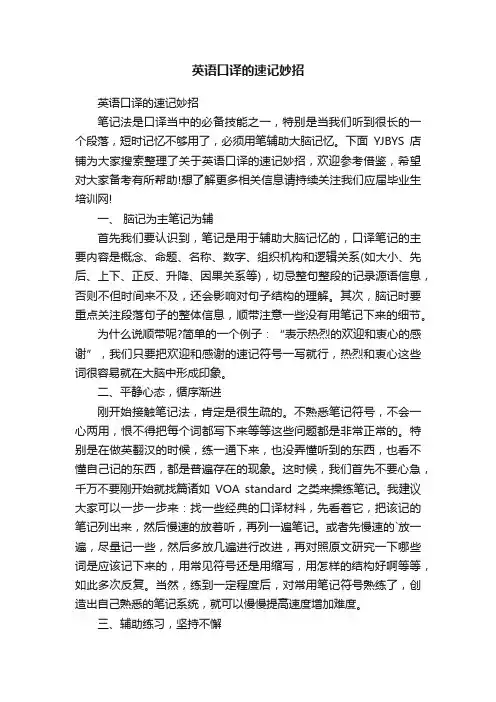
英语口译的速记妙招英语口译的速记妙招笔记法是口译当中的必备技能之一,特别是当我们听到很长的一个段落,短时记忆不够用了,必须用笔辅助大脑记忆。
下面YJBYS店铺为大家搜索整理了关于英语口译的速记妙招,欢迎参考借鉴,希望对大家备考有所帮助!想了解更多相关信息请持续关注我们应届毕业生培训网!一、脑记为主笔记为辅首先我们要认识到,笔记是用于辅助大脑记忆的,口译笔记的主要内容是概念、命题、名称、数字、组织机构和逻辑关系(如大小、先后、上下、正反、升降、因果关系等),切忌整句整段的记录源语信息,否则不但时间来不及,还会影响对句子结构的理解。
其次,脑记时要重点关注段落句子的整体信息,顺带注意一些没有用笔记下来的细节。
为什么说顺带呢?简单的一个例子:“表示热烈的欢迎和衷心的感谢”,我们只要把欢迎和感谢的速记符号一写就行,热烈和衷心这些词很容易就在大脑中形成印象。
二、平静心态,循序渐进刚开始接触笔记法,肯定是很生疏的。
不熟悉笔记符号,不会一心两用,恨不得把每个词都写下来等等这些问题都是非常正常的。
特别是在做英翻汉的时候,练一通下来,也没弄懂听到的东西,也看不懂自己记的东西,都是普遍存在的现象。
这时候,我们首先不要心急,千万不要刚开始就找篇诸如VOA standard之类来操练笔记。
我建议大家可以一步一步来:找一些经典的口译材料,先看着它,把该记的笔记列出来,然后慢速的放着听,再列一遍笔记。
或者先慢速的`放一遍,尽量记一些,然后多放几遍进行改进,再对照原文研究一下哪些词是应该记下来的,用常见符号还是用缩写,用怎样的结构好啊等等,如此多次反复。
当然,练到一定程度后,对常用笔记符号熟练了,创造出自己熟悉的笔记系统,就可以慢慢提高速度增加难度。
三、辅助练习,坚持不懈练笔记的同时呢,当然要辅助别的练习,比如每天影子练习锻炼一心两用的能力,做些视译和短时记忆的练习等等。
还是那句话,Practice makes perfect! 万事开头难,但是只要坚持下去,就会慢慢走上正轨。
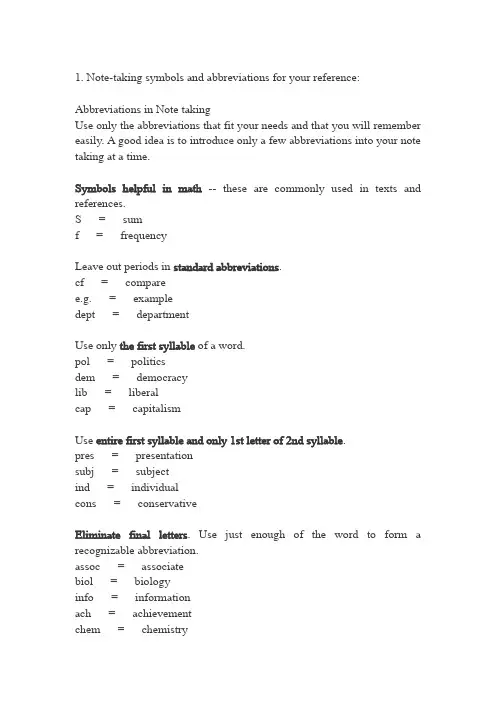
1. Note-taking symbols and abbreviations for your reference:Abbreviations in Note takingUse only the abbreviations that fit your needs and that you will remember easily. A good idea is to introduce only a few abbreviations into your note taking at a time.Symbols helpful in math-- these are commonly used in texts and references.S = sumf = frequencyLeave out periods in standard abbreviations.cf = comparee.g. = exampledept = departmentUse only the first syllable of a word.pol = politicsdem = democracylib = liberalcap = capitalismUse entire first syllable and only 1st letter of 2nd syllable.pres = presentationsubj = subjectind = individualcons = conservativeEliminate final letters. Use just enough of the word to form a recognizable abbreviation.assoc = associatebiol = biologyinfo = informationach = achievementchem = chemistrymax = maximumintro = introductionconc = concentrationmin = minimumrep = repetitionOmit vowels, retain only enough consonants to give a recognizable skeleton of the word.ppd = preparedprblm = problemestmt = estimatebkgd = backgroundgvt = governmentUse an apostrophe in place of letters.am't = amountcont'd = continuedgov't = governmenteducat'l = educationalForm the plural of a symbol or abbreviated word by adding s.chpts = chaptersegs = examplesfs = frequenciesintros = introductionsUse g to represent ing endings.ckg = checkingestg = establishingdecrg = decreasingexptg = experimentingSpell out short words such as in, at, to, but, for, and key.Abbreviations or symbols for short words will make the notes too dense with shorthand.Leave out unimportant words.Leave out the words a and the.If a term, phrase, or name is written out in full during the lecture, substitute initials whenever the term, phrase, or name is used again. For example, Center for Aerospace Sciences becomes CAS thereafter.Use symbols for commonly recurring connective or transitional words.& = andw/ = withw/o = withoutvs = against\ = therefore= = is or equalUse technical symbols where applicable.zb = German, for exampleibid = Latin, the same worko = degreesH2O = waterMore reference:Use standard maths, accounting, and science symbols. Examples:+ plus// parallelUse standard abbreviations and leave out full stops. Examples:eg exampleIT dept Information Technology departmentUK United KingdomUse only the first syllable of a word. Examples:mar marketingcus customercli clientUse the entire first syllable and the first letter of the second syllable. Examples:subj subjectbudg budgetind individualTo distinguish among various forms of the same word, use the first syllable of the word, an apostrophe, and the ending of the word. Examples:tech'gy technologygen'ion generalisationdel'y deliveryUse just enough of the beginning of a word to form a recognisable abbreviation. Examples:assoc associatedach achievementinfo informationOmit vowels from the middle of words, retaining only enough consonants to provide a recognisable skeleton of the word. Examples:bkgd backgroundmvmt movementprblm problemForm the plural of a symbol or abbreviated word by adding 's.' Examples: custs customersfs frequencies/s ratiosUse 'g' to represent 'ing' endings. Examples:decrg decreasingckg checkingestblg establishingSpell out, rather than abbreviate short words. Examples:inbutaskeyLeave out unimportant verbs. Examples:iswaswereLeave out unnecessary articles. Examples:aantheIf a term, phrase, or name is initially written out in full during the talk or meeting, initials can be substituted whenever the term, phrase, or name is used again. Example:January Advertising Campaign Budget JACBUse symbols for common connective or transition words. Examples:@ at2 to4 for& andw/ withw/o withoutvs againstCreate your own set of abbreviations and symbols. You may wish to develop separate sets of symbols and abbreviations for different courses or subjects.Other Symbols and Abbreviationsas a result of / consequences of <--->resulting in --->and / also +equal to / same as =following ffmost importantly *less than <greater than > especially esp/一、缩略词英语当中缩略词使用的频率很高,如IMP: important, ASAP: as soon as possible。
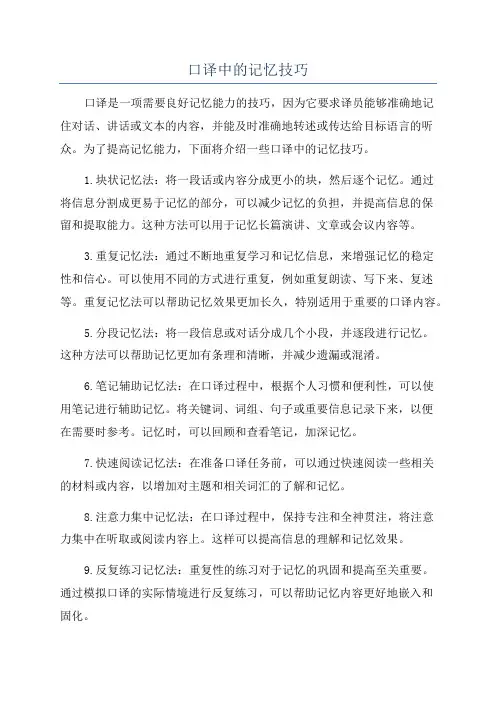
口译中的记忆技巧口译是一项需要良好记忆能力的技巧,因为它要求译员能够准确地记住对话、讲话或文本的内容,并能及时准确地转述或传达给目标语言的听众。
为了提高记忆能力,下面将介绍一些口译中的记忆技巧。
1.块状记忆法:将一段话或内容分成更小的块,然后逐个记忆。
通过将信息分割成更易于记忆的部分,可以减少记忆的负担,并提高信息的保留和提取能力。
这种方法可以用于记忆长篇演讲、文章或会议内容等。
3.重复记忆法:通过不断地重复学习和记忆信息,来增强记忆的稳定性和信心。
可以使用不同的方式进行重复,例如重复朗读、写下来、复述等。
重复记忆法可以帮助记忆效果更加长久,特别适用于重要的口译内容。
5.分段记忆法:将一段信息或对话分成几个小段,并逐段进行记忆。
这种方法可以帮助记忆更加有条理和清晰,并减少遗漏或混淆。
6.笔记辅助记忆法:在口译过程中,根据个人习惯和便利性,可以使用笔记进行辅助记忆。
将关键词、词组、句子或重要信息记录下来,以便在需要时参考。
记忆时,可以回顾和查看笔记,加深记忆。
7.快速阅读记忆法:在准备口译任务前,可以通过快速阅读一些相关的材料或内容,以增加对主题和相关词汇的了解和记忆。
8.注意力集中记忆法:在口译过程中,保持专注和全神贯注,将注意力集中在听取或阅读内容上。
这样可以提高信息的理解和记忆效果。
9.反复练习记忆法:重复性的练习对于记忆的巩固和提高至关重要。
通过模拟口译的实际情境进行反复练习,可以帮助记忆内容更好地嵌入和固化。
总结起来,提高口译记忆能力的关键是选择适合自己的记忆方法,并将其应用于口译的实践中。
不同的方法可以结合使用,以达到最佳的记忆效果。
此外,良好的口译记忆还需要持续的练习和努力,通过不断地实践和反馈来改进和提高。
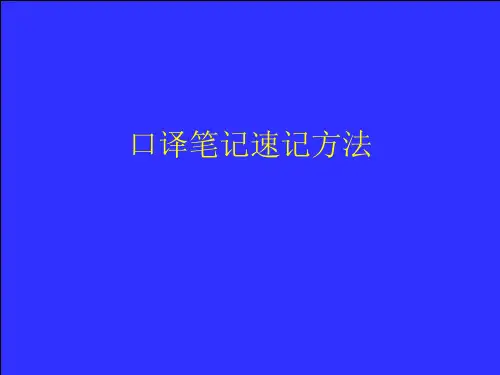

口译笔记训练——笔记法实例解析(配图片)Notetaking 1去年春天,我国遭遇了一场非典疫情重大灾害。
党中央、国务院把人民群众的身体健康和生命安全放在第一位,及时研究和部署防治非典工作。
将非典列为法定传染病管理,如实公布疫情,在全国范围内实行群防群控。
国务院和地方政府成立防治非典指挥部,统一调度人力物力财力,充分发挥城乡基层组织的作用,确保预防、救治工作紧张有序进行。
China suffered from a disastrous SARS outbreak last spring. The Party Central Com mittee and the State Council gave top priority to protecting people's health and live s and promptly investigated SARS and took steps to prevent and treat it. We enforc ed the Law of the People's Republic of China on the Prevention and Treatment of Communicable Diseases, formulated the Regulations on Public Health Emergency Res ponse, and classified SARS as a communicable disease. We reported the facts of th e SARS situation exactly as they were and mobilized the general public throughout t he country to control the outbreak. The State Council and local governments establi shed anti-SARS headquarters to coordinate human, material and financial resources and to make full use of primary-level organizations in both urban and rural areas, s o as to ensure that prevention and treatment work was done quickly and orderly.分析:要说明的一点是这个版本完全是我自己的版本,最终出来的结果也绝对和英文版的不一样。
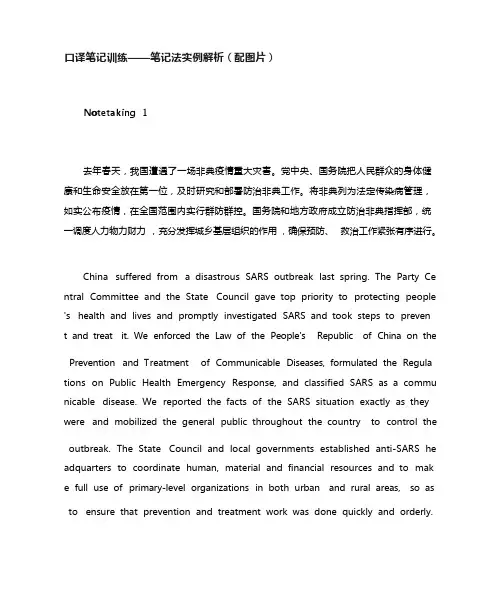
口译笔记训练——笔记法实例解析(配图片)Notetaking1去年春天,我国遭遇了一场非典疫情重大灾害。
党中央、国务院把人民群众的身体健康和生命安全放在第一位,及时研究和部署防治非典工作。
将非典列为法定传染病管理,如实公布疫情,在全国范围内实行群防群控。
国务院和地方政府成立防治非典指挥部,统一调度人力物力财力,充分发挥城乡基层组织的作用,确保预防、救治工作紧张有序进行。
China suffered from a disastrous SARS outbreak last spring. The Party Ce ntral Committee and the State Council gave top priority to protecting people 's health and lives and promptly investigated SARS and took steps to preven t and treat it. We enforced the Law of the People's Republic of China on the Prevention and T reatment of Communicable Diseases, formulated the Regula tions on Public Health Emergency Response, and classified SARS as a commu nicable disease. We reported the facts of the SARS situation exactly as they were and mobilized the general public throughout the country to control the outbreak. The State Council and local governments established anti-SARS he adquarters to coordinate human, material and financial resources and to mak e full use of primary-level organizations in both urban and rural areas, so as to ensure that prevention and treatment work was done quickly and orderly.分析:要说明的一点是这个版本完全是我自己的版本,最终出来的结果也绝对和英文版的不一样。
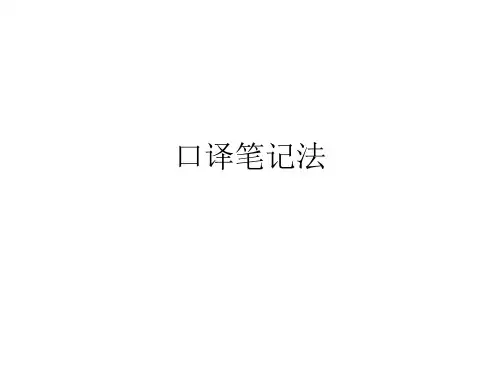

口译笔记法(Note taking in interpretation)Note taking in interpretation (1) 2007, Sunday, 04, 22, 17:00To directly talk about my notes by the use of experience.On some websites, I have seen suggestions from foreign interpretation teaching circles for many interpreters:1) See to it that the notes are logical and legible.2) To write as few words and symbols as possible.3) Better take notes in the target language.The first point of personal feeling is the most important, because interpretation notes should try hard to present the concept and structure of source language messages. (interpreter must convey a complete and logical message, including the tone, meaning, etc.) of the speaker Therefore, note taking in interpreting must have the characteristics of "Structurally-complete". Macro requirements as a wholeAs for the second point, I think it must be implemented on the premise of meeting the first point. It is not necessary to record information as little as possible, and ignore or even affect the basic requirements of interpreting notes -- structure. Micro detail requirementsAt third, I don't really agree. I think we should use the relatively good and relatively well identified language to record the source language and the target language. In addition,interpretation notes can be used in two languages. For example: the record of the concept of "I", "me" in Chinese and English "I", it is easy for us to choose the latter, because of its small strokes, fast and easy to distinguish; record, record "China", you can choose "" can also be written as "cn", because the two are to identify and record. Micro detail requirementsIn short, there are no special rules for the recording language of interpretation notes. As long as it conforms to the principles of "quick record and easy identification", my colleagues and I usually use two languages in interpreting.My interpretation note method (two) 2009-12-03 16:48 note is the key to advanced interpretation. The use of note is to supplement the short-term memory and endurance of the brain to ensure the accuracy of the translation and to ensure that it is not affected by the duration of the speaker.If it is completely dependent on memory and no unusual talent, even energetic young people are not qualified for advanced interpretation in terms of accuracy and endurance. As a practical example, I've met many times in my work. Senior interpreters don't have to rely on notes. However, the notes used in advanced interpretation are not consistent with the general concepts.Please note that each person's memory, thinking, and response have their own characteristics. There's no need to copy my way. The best way to take notes is to develop your own, suitable for their own system. My introduction is to give you a head, a direction, open the role of ideas.For example, the simpler the notes, the faster the record. But the notes are simple, and the requirements for short-term memory are relatively high. So, how much is the best note, easy because of people, need to find out for their own balance.The main point is:1. write fewer strokes. The line is faster than the writing. Line image, equivalent to the translation of "semi-finished product", helps the interpreter to see notes, speak out the translation. Two cases should use lines as much as possible:Words that express actions and movements. For example, the rising diagonal represents "development", "increase", "progress", "further", and "slash", "decrease", "deterioration" and so on with descending diagonals.Words and phrases indicating causality or pre and post relations. For example, a line represents "because / so"","... After "," in... "Before", in order to reflect the relationship between up and down.2. little words and more meanings. Develop a habit of taking notes of no more than one word. There are a large number of words in Chinese that are composed of two or more than two words. As long as you see one of them, your short term memory should be able to fill in the rest of the word. No need to write more. For example,"China" at most write a "medium"". "Beijing" writes "North" atmost". English words are also treated in the same way. "Politics" writes "poli", "government", "gov", and so on. In addition, it is necessary to develop the ability to interact with notes and memory; to see the ability of a word to speak a few words, or even a string of words. In context, it's not difficult. For example, talking about China's current situation, listening to "reform, opening up", remember a "change" word, it is not difficult to tell the original text from short-term memory. When you hear "British Prime Minister Tony Blair", remember "PM", also can say the original text.3. little lines and more fingers. Generic small line / mark. Otherwise, in their own familiar Chinese and English, and compiled a set of unfamiliar with the use of code, will lead to need to think about what symbol to use, counterproductive.4. less horizontal more vertical. Take the ladder structure from the top down and record the horizontal record as little as possible when you write it. The ladder structure vividly reflects the logical structure of the context, simplifies the thinking process of the interpreter, and facilitates the translation.5. fast writing. We must develop our own Chinese character fast writing system. Note taking is entirely self - observation, and it only takes a few minutes to read. Many strokes of Chinese characters are reduced without affecting recognition. I speak of here is not sloppy, but in addition to the actual interpretation often have to scribble, take some time to practice or work in interpreting word ponder, can look at how to reduce stroke or stroke, straighten out a word.6. clear end. In interpreting, the speaker says a paragraph, stops, makes an interpreter, and then goes on. In this way, there must be definite boundaries between the previous paragraph and the next paragraph. At the end of the last time, it became the beginning of the next translation. Its importance is that, if the notes are started from the 1/3 book, the next paragraph may write a 2-3 page, turn back when interpreting, eyes cannot determine which line the top of the page, or is the starting point of the symbol translation content. So you need to mark it. When I first started, I learned that every speaker made a line at the end. Later found, from the speaker opening, to that time I had to speak as an interpreter is very valuable, are often used to supplement notes, reluctant to draw the line to end. Later, I just put off the procedure until I finished the translation. As I finished speaking, and the speaker started this time within my grasp, so when I finished, I made a line, and then motioned the speaker to continue.Besides, I don't think the line is clear enough, so now turn it into a circle and a line.Finally, talk about the equipment you need.I suggest you use a notebook with a loose ring, see the following photos. It's easy to flip back and forth with a loose ring. The size of your laptop is comfortable. I like to use A5 made in england. I lay in my hand, just right. It's just British notebooks that are designed for shorthand. Blank pages are more ideal.Finish a page, turn over a page. The speaker after closing, grabbed all turn back, left eye is at the beginning of this piece of. Then, translate a page, turn over a page. After the translation, the pages of the past are pressed into the palm of the hand. This is a clear separation of the past and the next paragraph with the palm of the hand. That's important. Otherwise, it is prone to the speaker after the closing, the home page for your back and forth embarrassment.If you're sitting at your desk, your laptop is on the desk, and you're finishing a page, turning over a page. Don't forget to press the completed notes page to your notebook before the speaker speaks.Pen, I suggest using a press type. In this way, a handheld book, the other hand can always take out a pen, a press began to remember. If the pen is rotated, it needs two hands to operate. If the cap is not tight, but also from time to time off, a distraction. Generally I am used to bring two pens,Too many times to avoid the exhaustion of inkNote taking symbols 32009-08-25 22:25 two, letters and images Z represent "human" people/person, because "Z" looks like a head, and it is usually written in the upper right corner of a word or symbol. For example: Japanese: JZ. C stands for government, rule: government, govern, Greek letter C, /ga:ma/, approximate government, so C is used to represent govern, government. Governmental official can be expressed as CZ P representing Politics: politics, political, Greek alphabet P, /pai/, approximate politics, political. Then politician can beexpressed as PZ E representing the total number: total, totally, entire, entirely, on the whole, all in all, to sum up, ect. E mathematical notation representing the total value. G represents efficiency: efficient, effective. G is the symbol of efficiency. Q stands for inflation: inflation, because the sign resembles a rising balloon. A means agriculture: agriculture. agriculture is often used, so use initial letters instead. B represents business: business. C X represents conflict and contradiction: "X" in conflict, confrontation "C X" stands for opposition, and the letter "C" reduces the concept of opposition to conflict and confrontation. W means work, profession: work, employ, etc.. It's the first letter of work. So WZ can be used to represent worker, and W (Z is employer above the letter, employee below the letter). I stands for Industry: industry, industrial letter I is like a chimney, so it can be used to represent industry. U U looks like a goblet, and says in the note that the Treaty (agreement) is generally expressed only after successful negotiations and agreements". If it is filled with 2 x x in U, it can be expressed as bilateral (two-sided), and 3 is expressed as trilateral (three sides). Fill in U, fill in 1, say: Unilateralism (unilateralism), fill in M (multiple) to express multilateralism.Note the symbol 52009-08-25 22:29 said: ups and "twists and turns" downs, twists and turns, etc. four, said that "more" + mathematical symbols: many, lots of, a great deal of a good, many of, etc. + + (+2) said "comparative" more +3 said: "the most advanced multi" Most said: "little": little, few, lack, in short of/ be in shortage of etc. * said "error", "error" and "bad" concept: wrong/incorrect something, bad, notorious, negative, etc. > said "more than" bigger/larger/greater/morethan/better than etc., the concept of "high the concept of" superior to, surpass, etc., "said" less than "concept:less/smaller etc. said," low "concept: inferior to, etc. =" equal "concept: means that, is to say, in othe R words, the same as, be equal to etc., said the "rival" concept: a match, rival, competitor, counterpart, etc. () said "... Between...": among, within, etc. and said "different" concept: be different from etc., said the "invincible" concept: matchless, peerless etc. said, "about" concept: about/around, or so, approximately, etc. / said "no", "eliminate" concepts such as: cross out, eliminate, etc.Five, punctuation, etc.: a variety of verbs that say "say", "speak", "talk", "marks", "announce", "declare", "etc.", "", "question", and "issue", for example: "TW"(DOT) the position of this "." point is different. The concept of ".D" means "yesterday", ".Y" means "last year", ".2m" means two month ago. "Y" this year, "y2." two year later "next week", "wk." can be expressed as a representation of "good" when turning said state, right/good, famous/well-known etc., said "agree", stand up for, support agree, with sb, certain/ affirmative, etc. said, "" state: important, exemplary (model) best, outstanding, brilliant, etc. n, said the "communication" state: exchange, mutual, etc. & said "and", "and" and together with, along, with, accompany, along, with, further, more, etc., said "the end": end stop, halt, bring, sth to a standstill/stop etc., six, a long word processing method -ism - M for example: socialism Sm -tion - N Standardization: Jane (for example Standard) stdn -cian Jane - O for example: technician techo -ing - G for example: Marketing (Marketing) MKTg -ed - D acceptedacptd -able/ible/ble for example: for example: available avbl - BL - MT -ment amendment amdmt -ize for example: Jane wrote for the Z example: recognize regz -ful - FL for example: meaningful mnflA collection of shorthand symbols for interpretation! (1) 2007-01-04 19:09:04, medium and small. Abbreviations:Abbreviations in Note takingUse only the abbreviations that fit your needs and that time. you will remember easily. A good idea is to introduce only a few abbreviations into your note taking at a1.Symbols helpful in math -- these are commonly used in texts and references.S = sumF = frequencyLeave out periods in standard abbreviations.CF = compareE.g. = exampleDept = DepartmentUse only the first syllable of a word.Pol = politicsDEM = democracyLib = liberalCap = capitalismUse entire first syllable and only 1st letter of 2nd syllable.Pres = presentationSubj = subjectInd = individualCons = conservativeEliminate final letters. Use just enough of the word to form abbreviation. a recognizableAssoc = AssociateBIOL = biologyInfo = informationACh = achievementChem = chemistryMax = maximumIntro = introductionConc = concentrationMin = minimumRep = repetitionOmit vowels, retain only enough consonants to give a recognizable skeleton word. of thePPD = preparedPrblm = problemEstmt = estimateBkgd = backgroundGVT = governmentUse an apostrophe in place of letters.Am't = amountCont'd = continued政府=政府educat'l =教育形成一个符号或缩写词的复数加schpts =章EGS =实例FS =频率介绍:介绍用g表示ing结尾。
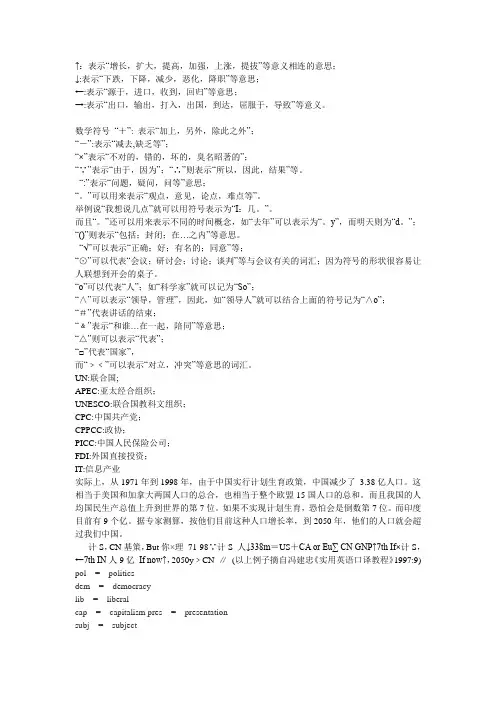
↑:表示“增长,扩大,提高,加强,上涨,提拔”等意义相连的意思;↓:表示“下跌,下降,减少,恶化,降职”等意思;←:表示“源于,进口,收到,回归”等意思;→:表示“出口,输出,打入,出国,到达,屈服于,导致”等意义。
数学符号“+”: 表示“加上,另外,除此之外”;“-”:表示“减去,缺乏等”;“×”表示“不对的,错的,坏的,臭名昭著的”;“∵”表示“由于,因为”;“∴”则表示“所以,因此,结果”等。
“:”表示“问题,疑问,问等”意思;“。
”可以用来表示“观点,意见,论点,难点等”。
举例说“我想说几点”就可以用符号表示为“I:几。
”。
而且“。
”还可以用来表示不同的时间概念,如“去年”可以表示为“。
y”,而明天则为“d。
”;“()”则表示“包括;封闭;在…之内”等意思。
“√”可以表示“正确;好;有名的;同意”等;“⊙”可以代表“会议;研讨会;讨论;谈判”等与会议有关的词汇;因为符号的形状很容易让人联想到开会的桌子。
“o”可以代表“人”;如“科学家”就可以记为“So”;“∧”可以表示“领导,管理”,因此,如“领导人”就可以结合上面的符号记为“∧o”;“#”代表讲话的结束;“﹠”表示“和谁…在一起,陪同”等意思;“△”则可以表示“代表”;“□”代表“国家”,而“﹥﹤”可以表示“对立,冲突”等意思的词汇。
UN:联合国;APEC:亚太经合组织;UNESCO:联合国教科文组织;CPC:中国共产党;CPPCC:政协;PICC:中国人民保险公司;FDI:外国直接投资;IT:信息产业实际上,从1971年到1998年,由于中国实行计划生育政策,中国减少了 3.38亿人口。
这相当于美国和加拿大两国人口的总合,也相当于整个欧盟15国人口的总和。
而且我国的人均国民生产总值上升到世界的第7位。
如果不实现计划生育,恐怕会是倒数第7位。
而印度目前有9个亿。
据专家测算,按他们目前这种人口增长率,到2050年,他们的人口就会超过我们中国。

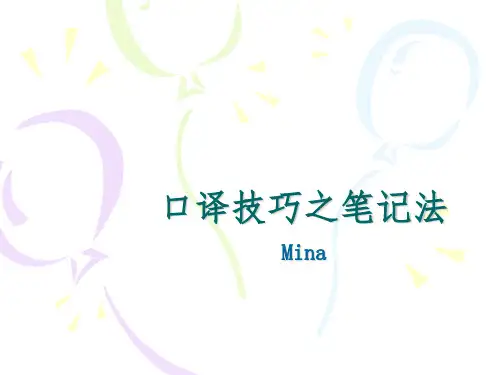
2.、标点符号4,、箭头符号进行英语口译时,大家可能常会用到一些缩略词做一些简单的笔记。
这里为大家总结了较全的缩略词,首先为大家介绍的是缩略词A—Cacc = account, accountantacdg = accordingacpt = acceptad = advertisementadm = administrationads = addressadv = adviceagr = agricultureagt = agentalt = altitudea.m. = ante meridiem = before noon AMAP = as much as possibleamb = ambassadoramt = amount anal = analysisanc = ancientanon = anonymousans = answerapp = appendixApr = Aprilapt = apartmentarch = architecturearr = arrive; arrivalASAP = as soon as possible ass = assistant; associationat = atmosphere; atomicatt = attorney; attentionAug = Augustaux = auxiliaryav = averageave = avenuea.w.l. = absent with leave (准假)a.w.o.l. = absent without official leave (无故缺席)B.A. = Bachelor of Artsbal = balanceB.C. = before Christbd = boardbdl = bundlebk = bank; bookbkts = basketsB/L = bill of lading (提单)BLDG = buildingbp = birthplacebr = branch; brotherB.S. = Bachelor of Sciencebu = bureau C = capacity; century; chapter; centigrade; cost; city; centercal = calendar; caliber; caloriescap = capital; captaincat = catalogcc = carbon copy (复印件;抄送) CEO = chief executive officercert = certificateCFM = confirmcncl = cancelcp. = comparecit = citizenciv = civil; civilizationclk = clerkcml = commercialco. = companyc/o = care of(转交)col = college; colorcom = commentary; common; communication; communitycomm = commissioncomp = complete; computer; competitioncon = conclusion; againstcond = conditioncont. = continent; continuedcorp = corporationcust = customer; custom; customs上文我们为大家总结了英语口译缩略词A—C的内容,这里为大家总结的英语口译笔记常用缩略词区间段D—K 的词汇。
一、口译笔记的符号系统和缩略语语言是一个符号系统(包括文字符号)。
用各种符号作记录,概括性强、重点突出、一目了然。
学习一些常规口译笔记中经常使用的符号与缩写词是很有好处的。
在此基础上,每个人也可以形成一套自己常用的、熟悉的、有效的笔记系统。
下面归纳几种相对固定的符号和简写形式,供大家在练习和实践中参考。
(一)箭头“→”表示到达、传达:go into,arrive at,give to,send to,present to, etc. 导致、引导:lead to, result in, in the direction of, etc.“←”表示来自于:be/come from,return,receive from, etc. 追溯到:come/go back to,originate in, etc.“↑”表示上升:up/upward/rise,increase,arise,ascend, etc. 发射、起飞、升空:launch,ascend, skyrocket, etc.发展、加强、推进:develop,strengthen,promote, etc.“↓”表示向下、下降:down/downward/drop, decrease, jump, etc. 减少、恶化:reduce, deteriorate, go down, etc.(二) 数学符号“+”表示和、还有、另外、加上、多:and, in addition to, furthermore, many, lots of, etc.“-”表示减少、除去、少:minus, lack, in short of, little, few, etc.“×”表示错误、没有、反对、冲突:wrong, something bad, negative, conflict, confrontation, etc.“>”表示大于、超过、多于:greater, larger or more than, better than, surpass, more and more, etc.“<”表示小于、不如、次于、比不上:smaller than, fewer/less than, worse than, inferior to, etc.“=”表示等于、相当于、一样:the same as,that is to say,in other words,be equal to, etc. 对手:match/rival/competitor, counterpart.“≠”表示不等于、不同:not equal to, be different from, etc.“≈”表示大约、左右:about/around,or so,approximately, etc.“∵”表示由于、因为:because, as, due to, thanks to, owing to, etc.“∴”表示所以、因此、因而、结果:so, therefore, as a result, consequently, etc.(三) 标点符号“:” 表示说:say, speak, talk, marks, announce, declare, etc. 意见、观点、主意:opinion, idea, viewpoint, etc.“?” 表示问题:question,issue,problem, etc.“.”点的位置不同表示的概念也不一样:“.d”表示yesterday,“.y"表示last year,“.2m”表示two months ago,“y”表示this year,“y2.”表示two years later/in two years,“next week”,可以表示为“wk.”“()” 表示在……之间:among, within, etc.(四) 其它符号“√” 表示好:right/good,famous/well-known,etc. 同意:stand up for,support,agree with somebody, certain/ affirmative, etc.“& ” 表示和、与:and,together with,along with,accompany,along with,further more,etc.“☆” 表示重要的、杰出的、优秀的、榜样:important,best,outstanding,brilliant,model, etc.“∥” 表示结束:end,stop,halt,bring something to a standstill/stop, etc.“°”表示人、者:person, people, 如经济学家可以表示为“经°”,中国人可以表示为“中°”,etc.“⊙”表示会议、讨论、谈判:meeting, seminar, discussion, negotiation, etc.“♂”表示男人:man, male, boy, etc.“♀”表示女人:woman, female, girl, etc.“□”表示国家:country, state, nation, etc.“△”表示代表:represent, on behalf of, etc.“∽”表示交流、交换、替代、相互:exchange, mutual, each other, communication, replace, etc.(五) 缩略词英语缩写词的写法一般有以下几种:∙拿掉所有元音。
口译笔记法〔英译汉〕
1、口译简介
Listening——Understanding——Decoding
2、常见问题
1)笔记贪多贪全
2)卡在生词
3)卡在长句〔1.省略法2.增译法3.重译法4.转译法5.分译法〕〕4)不熟悉口音
5)不熟悉听力内容
6)欠流利
7)词汇量不够
8)心里紧张
9)多米诺骨牌效应
10)“语不惊人死不休”的心理
3、解决方法
技巧总结:1、每行记名词主语宾于,谓语用脑记。
2、并列定语用大括号由上至下写
3、箭头号表谓语另起一行。
4、符号:专有名词
形象记忆法三角形表城市倒三角表农村
箭头表动作,方向,逻辑圈圈表人,s表复数
建立自己的符号体系平日训练积累。